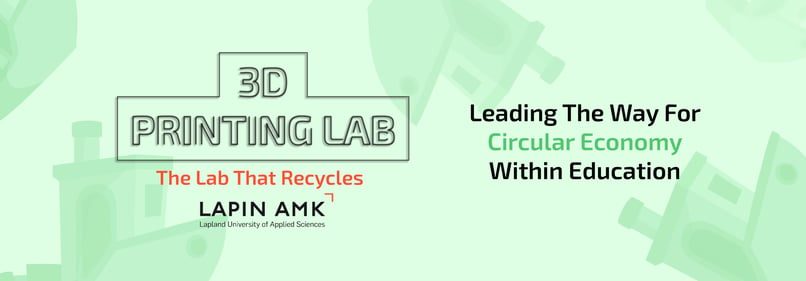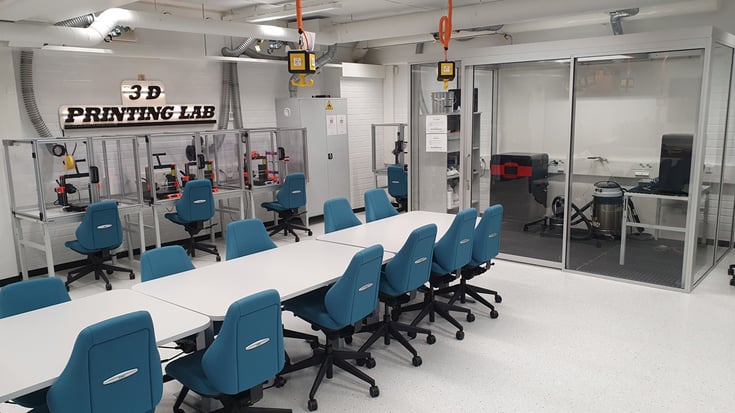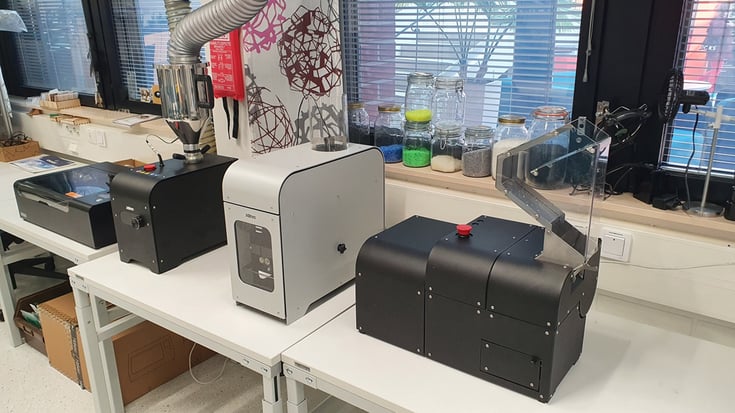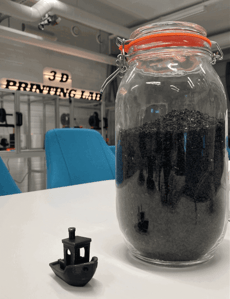Share this
Education With Circular Economy at Lapland University of Applied Sciences
by 3devo on Aug 30, 2021 9:33:00 AM

At Lapland University of Applied Sciences (Lapland UAS) in Northern Finland, the mechanical engineering department is a testing ground for many future-friendly technologies. Senior lecturer, Ari Pikkarainen, who oversees student projects involving 3D printing, has ambitious plans for the 3D printing laboratory at the mechanical engineering department. In Ari’s wish list is a setup where old parts and prototypes go into storage shelves instead of the waste bin, organized by material and color, ready to be picked up and recycled into new printing filament. In other words, the manifestation of a circular economy within the lab.
There’s plenty to do before this dream becomes a reality, but things have progressed quickly over the past couple of years. Since the establishment of a full-fledged additive manufacturing setup within the department, a lot of exploration has happened in polymer printing technologies, particularly fused deposition modelling (FDM), stereolithography (SLA), and selective laser sintering (SLS). Besides utilizing these technologies to develop new products and solutions, efforts have been on making the entire setup robust and sustainable.
Sustainability is at the core of Lapland University’s approach to education and research. Technology departments here focus on minimizing waste, using renewable raw materials, and creating a circular economy. This is why the 3D printing lab at the mechanical engineering department was the perfect place for Nicole Körner’s thesis project.
3D printing lab at Lapland UAS (Photo courtesy of Ari Pikkarainen)
Bringing Recyclability into Manufacturing
Nicole Körner recently spent a year at Lapland University of Applied Sciences. She was a Double-Degree student from University of Applied Sciences, FH Technikum Wien, Austria, where she was pursuing a renewable energy degree. In her final year at Lapland, Nicole stepped into the world of mechanical engineering. Under Ari’s supervision, she worked hands-on with polymers, developing efficient ways to recycle them.
Nicole’s thesis looked at the feasibility of converting recycled polylactic acid (PLA) into 3D printing filament. The choice of material came from the amount of PLA waste produced in the 3D printing lab – a facility that is heavily used for both course work and independent projects. Nicole’s research also found common ground with the department’s existing efforts to introduce a filament making and recycling solution in the 3D printing lab.
Ari shares, “I notice that the practices currently available at institutes and universities don’t talk about the recyclability of 3D printing so much.” As long-time practitioners of circular economy in education, Lapland UAS didn’t want to take the same route. “When we were starting to design the laboratory, we already knew we wanted to have a filament recycling device,” Ari adds.
Equipped with guidance from her supervisors, Nicole conducted her own market research into the filament making and polymer shredding solutions currently available. Her preference was a compact, desktop-friendly solution that was easy to use and could handle a variety of materials. Ari had similar requirements. In particular, he wanted a complete solution that took care of all aspects of recycling and filament extrusion and was also easy to use.
“We didn’t want to buy one machine from one distributor, the second from another, or build something on our own,” Ari explains. He feels that this is an important consideration for educational institutes because developing and maintaining laboratories is time-consuming. “If you have to spend time to adjust and tweak the machines, it will take away time from the actual learning.”
Set-up of the 3devo full solution in the 3D printing lab at Lapland UAS (Photo courtesy of Ari Pikkarainen)
The 3devo kit consisting of the Composer 450 filament maker, Shr3d It plastic shredder, and the Airid polymer dryer was finally picked for the laboratory. Nicole then set about using these machines to recycle discarded PLA objects and make new filament out of them.
I wanted the students to discover what they can do with so-called ‘waste’– Nicole
For Nicole, it was an entirely new experience working hands-on with engineering equipment. From unboxing and setting up the machines, to finding the right settings for extruding the PLA, it was a first time for everything. The ability to see the results in real time, though, made it an exciting and rewarding journey for her.
“Initially, I was a bit scared,” Nicole shares. “Because I’m not a mechanical engineering or a material science student, so I thought ‘hmm, how am I going to manage?’ But everything was just so easy.”
Nicole started out by mixing different proportions of virgin and recycled PLA. During the initial filament diameter fluctuations and shredding difficulties, she was assisted by her supervisors and received support on the 3devo forum. Eventually, she arrived at high-quality filament made entirely out of recycled PLA.
She considers this as quite an achievement. “I never thought I’d be able to make filament out of 100% recycled PLA. I thought 50/50 would be the maximum!” With these results, she has established that it’s possible to find a new use for every discarded piece of PLA at the lab. Which was the purpose of her thesis – to introduce recycling as a working process in the lab and set the wheels in motion for a circular economy there.
Jar full of recycled PLA regrinds and a recycled PLA 3D Print (Photo courtesy of Nicole Körner)
Making Engineering Education Productive and Versatile
Nicole Körner’s project is a small but significant step towards a larger goal that many educators and researchers are trying to achieve. Ari is optimistic about the future. A versatile and efficient filament extrusion and recycling system, he feels, is just what is needed to reap all the benefits of 3D printing.
“If you think about companies and the industry, the biggest obstacle with the adoption of additive manufacturing, is the lack of knowledge – how to utilize or benefit from 3D printing.”– Ari
Ari’s doctoral thesis was built around this subject, and it’s even more relevant now that additive manufacturing has been adopted by so many industries. Making sustainability a core aspect of engineering education would result in numerous socio-economic benefits. It would also ensure that novel technologies like additive manufacturing serve as an asset as we step into the future.
What has started as an experiment with recycling PLA, the most used material at the Lapland UAS’s 3D printing lab, is now set to expand to other materials as well. As a next step, Ari hopes to explore PLA composites (such as PLA reinforced with fibers) and their manufacturing and recyclability.
We feel confident that the zero-waste 3D printing laboratory Ari has in mind is not too far away. Looking forward to more exciting updates from the Lapland UAS team!
Share this
- March 2025 (1)
- January 2025 (1)
- December 2024 (2)
- November 2024 (3)
- October 2024 (4)
- September 2024 (2)
- August 2024 (3)
- July 2024 (6)
- June 2024 (3)
- May 2024 (2)
- April 2024 (1)
- March 2024 (1)
- January 2024 (1)
- November 2023 (2)
- October 2023 (5)
- September 2023 (2)
- August 2023 (1)
- July 2023 (1)
- May 2023 (1)
- December 2022 (3)
- August 2022 (1)
- June 2022 (1)
- May 2022 (2)
- April 2022 (2)
- March 2022 (7)
- February 2022 (2)
- January 2022 (3)
- December 2021 (3)
- November 2021 (3)
- October 2021 (2)
- September 2021 (3)
- August 2021 (3)
- July 2021 (2)
- June 2021 (1)
- March 2021 (1)
- October 2020 (1)
- June 2020 (1)
- May 2020 (1)
- April 2020 (4)
- November 2019 (1)
- July 2019 (2)
- June 2019 (1)
- May 2019 (1)
- March 2019 (1)
- November 2018 (1)
- September 2018 (1)
- January 2018 (1)
- October 2017 (1)
- September 2017 (1)
- July 2017 (1)
- June 2017 (1)
- May 2017 (1)
- January 2017 (1)
- December 2016 (3)
- November 2016 (2)
- October 2016 (1)
- May 2016 (2)
- August 2015 (2)
- July 2015 (1)


